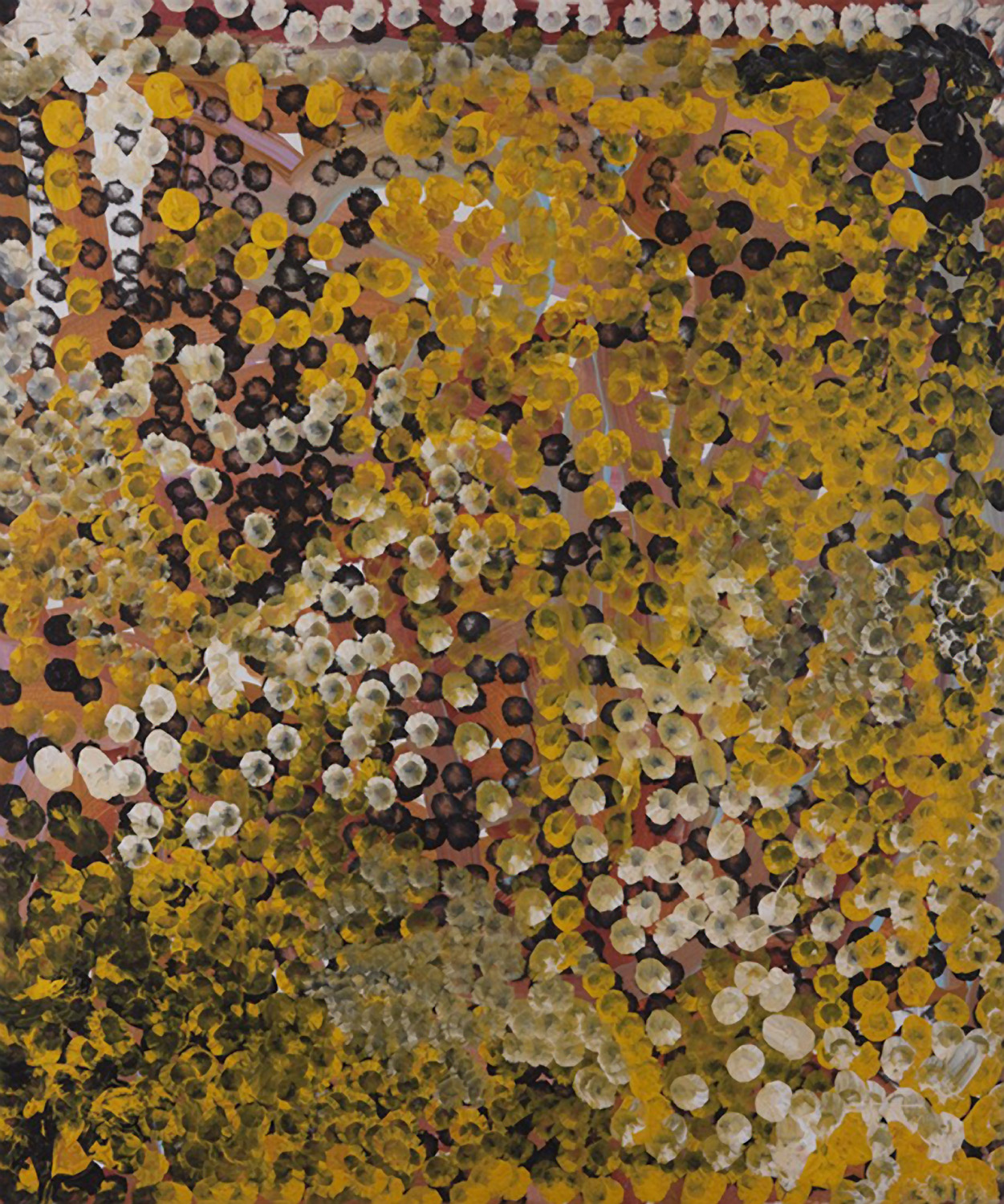Emily Kame Kngwarreye
Untitled (triptych), 1995
synthetic polymer paint on canvas
66.0
x 55.0
cm
with Dacou numbers 'EK450'
SOLD
Provenance
DACOU Gallery, Adelaide
Private collection, Brisbane
Fine Aboriginal Art, Deutscher-Menzies, 27 June 2000, lot. 111
Private collection, Melbourne
''Whole lot, that's whole lot, Awelye (My Dreaming), Arlatyeye (pencil yam), Arkerrthe (mountain devil lizard), Ntange (grass seed), Tingu (Dreamtime pup), Ankerre (emu), Intekwe (favorite food of emus, a small plant), Atnwerle (green bean), and Kame (yam seed). That's what I paint, whole lot.'' (Emily Kame Kngwarreye 1990, translation by Kathleen Petyarre)
As one of the five major Indigenous artists, Emily Kame Kngwarreye's work needs little introduction. Born at Utopia circa 1910, her paternal clan Country Alkahere spans one of Australia's most remote regions some 230kms northeast of Alice Springs.
After decades of responsibility to her Dreamings shown in mark making on body and in sand, as a senior Anmatyerre custodian her marks found enduring expression on canvas. Across a short but prolific period of production from 1988 to her passing in 1996, it is understood that she completed an average of one painting per day in testament to the Dreamings, which perpetuated her life force.
Her subject, Alkahere unendingly renewed itself and gave form to new expression in the passing of each day. In her work is to be seen, the visual expression of her lived experience as a part of her Country. These works each contain the hallmarks for which Emily was revered, the expansive shifting tonalities, and free-floating dots veiling linear undertrackings, applied with the innate mastery of one of the country's few true colourists.

Emily Kame Kngwarreye emerged in the 1980s and 1990s as one of Australia's most important contemporary painters. Known affectionately just as “Emily”, Kngwarreye’s work garnered international acclaim in her lifetime and was instrumental in developing interest for Australian Aboriginal art both domestically and overseas. Heralded as a seemingly intuitive artist who came to painting and global attention late in her life, Kngwarreye’s art is better understood as the product of lifelong artmaking in the Anmatyerre traditions of drawing in the earth or painting onto bodies for ceremony.
Throughout her life, Kngwarreye painted her country, Alhalkere, north of Alice Springs, where she was born in around 1910. It was not until she was around 10 years old that she first encountered a white man, around the time that pastoralists annexed Alhalkere and neighbouring lands, naming the area “Utopia”. Kngwarreye was forced to work on these stations, tending for animals, leading camel trains to and from the local mines, and even working as a miner herself. At the same time, she became a ceremonial leader and Elder, continuing her people’s traditions and playing an instrumental role in successfully advocating for the return of Utopia Station in 1979 to Traditional Owners.
In 1977, Kngwarreye was one of 20 founding members of the Utopia Women’s Batik Group. She worked in this medium until 1988, when she transitioned to acrylic paintings. In 1989, Kngwarreye was awarded the inaugural CAAMA Fellowship, which began to move away from the conventional egalitarianism of the Batik Group by allowing Kngwarreye to flourish as an individual artist. In 1992 she was awarded the Australian Artists Creative Fellowship and major works began to enter Australian public collections with sellout shows of her paintings.
After Kngwarreye’s death in 1996, her reputation continued to grow. In 1997 her work was posthumously exhibited at the Venice Biennale. In the same year the Queensland Art Gallery, Brisbane presented a major survey exhibition Emily Kame Kngwarreye: Alhalkere: Paintings from Utopia, which travelled to the Art Gallery of New South Wales, Sydney the National Gallery of Victoria, Melbourne and the National Gallery of Australia, Canberra. A major retrospective of her work was mounted in 2008, by the National Museum of Australia, Canberra, which toured to the National Museum of Art in Osaka and the National Art Centre in Tokyo, Utopia: The Genius of Emily Kame Kngwarreye.